A summary of the USSR space exploration, types of missiles and the most significant victories in this field. Part 2
Good afternoon, my dear reader, I continue my narration about the launch vehicles of the USSR and the most interesting loads that they delivered to space.

Booster "Lightning"

Modified version of the Molniya-M launch vehicle
')
As is known, there are eight planets in the solar system. These are Mercury, Venus, Earth, Mars, Jupiter, Saturn, Uranus and Neptune. Pluto, previously considered the planet of the Solar System, is now excluded from this “honorable” series. The degree of remoteness from the Sun, the Earth is in third place. The planet nearest to the Sun is Mercury, and the most distant is Neptune.
The shortest distance from these planets to the Earth is as follows (in millions of km):
Mercury - 91.6
Venus - 41.4 the closest planet to Earth.
Mars - 78.3
Jupiter - 628.4
Saturn - 1277.4
Uranium - 2721.4
Neptune - 4347.4
We will need this information later, in order to understand the global nature of the steps taken by the USSR during the space race.
Booster "Lightning" 8K78. The first launch is October 10, 1960. And its modification "Molniya-M" 8K78M First launch April 2, 1964.
Developed for launching interplanetary spacecraft to Venus and Mars, then - for launching lunar spacecraft of the E-6 and E-6C series ("Luna-4" - "Luna-14") Gained fame in connection with the launches of communications satellite "Lightning" on orbits.
With the help of these devices, the problem of providing long-distance telephone and telegraph communication and retransmission of programs of the Central Television was solved.
It was later used for launching satellites of the Oko Alert Warning System (EWS).
It should be noted that this booster is one of the most successful. Now it is based on the Soyuz launch vehicles. Separately, it can be said about the Luna satellites that she launched into space. Of the 10 satellites, only 5 coped with their tasks. I would especially like to mention the station "Luna-9" and "Luna-13"
The Luna-9 station for the first time in the world made a soft landing on the surface of the Moon in the Ocean of Storms, west of the craters Reiner and Marius, at the coordinates of 64 degrees 22 minutes west longitude and 7 degrees 8 minutes north latitude. 7 communication sessions with a total duration of more than 8 hours were conducted with the station. During these sessions, the AMC transmitted a panoramic image of the surface of the Moon near the landing site.
The Luna-9 station worked for 7 days and transmitted three photo-panoramas of the lunar surface to Earth. In addition, the station was equipped with a penetrometer gage meter, radiation densitometer and dynamograph, with which the first ever instrumental study of the density and strength of the lunar soil surface layer was conducted
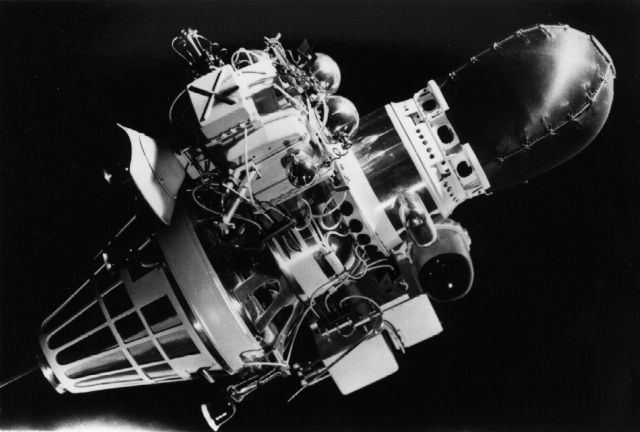
"Luna-9"

"Luna-9" with the landing module.
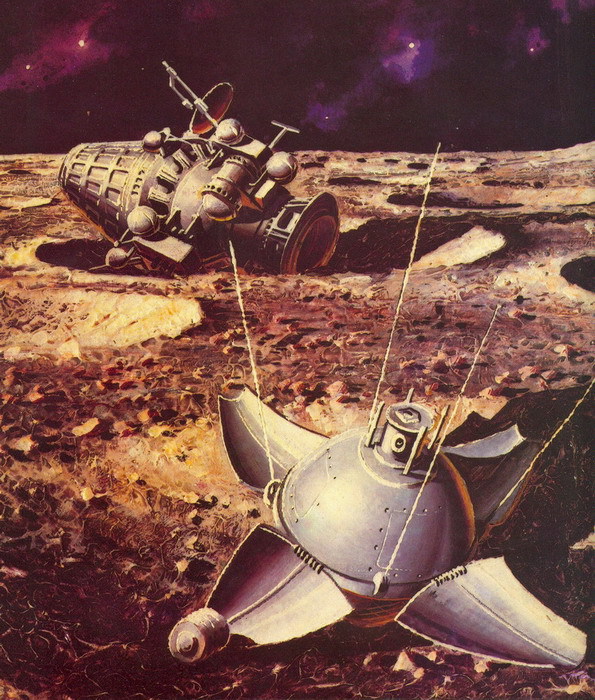
Picture of the descent module "Luna-9" on the background of its orbital module
The remaining stations “Luna - 10,11,12,14” did not land on our natural satellite, but did measurements of the near-moon space.
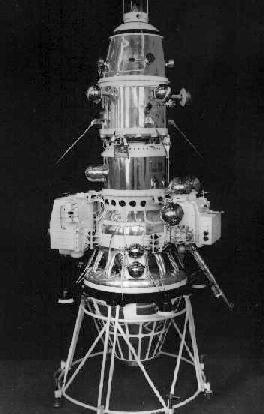
"Luna-10"
Mars and Venus satellites were also launched on these launch vehicles. The USSR once again threw primacy from the United States, but now it was the launch of a satellite to other planets.
Mars-1 is an automatic interplanetary station of the second generation of the Mars program. One of the three AMC series M-62. The spacecraft was designed to conduct scientific research of Mars from the flight trajectory, transmitting information about the interplanetary space and about the space around Mars. The first spacecraft for a flight to Mars, the Mars-1, was created at the SPO Design Bureau. Korolev and launched in 1962, but did not reach the planet.
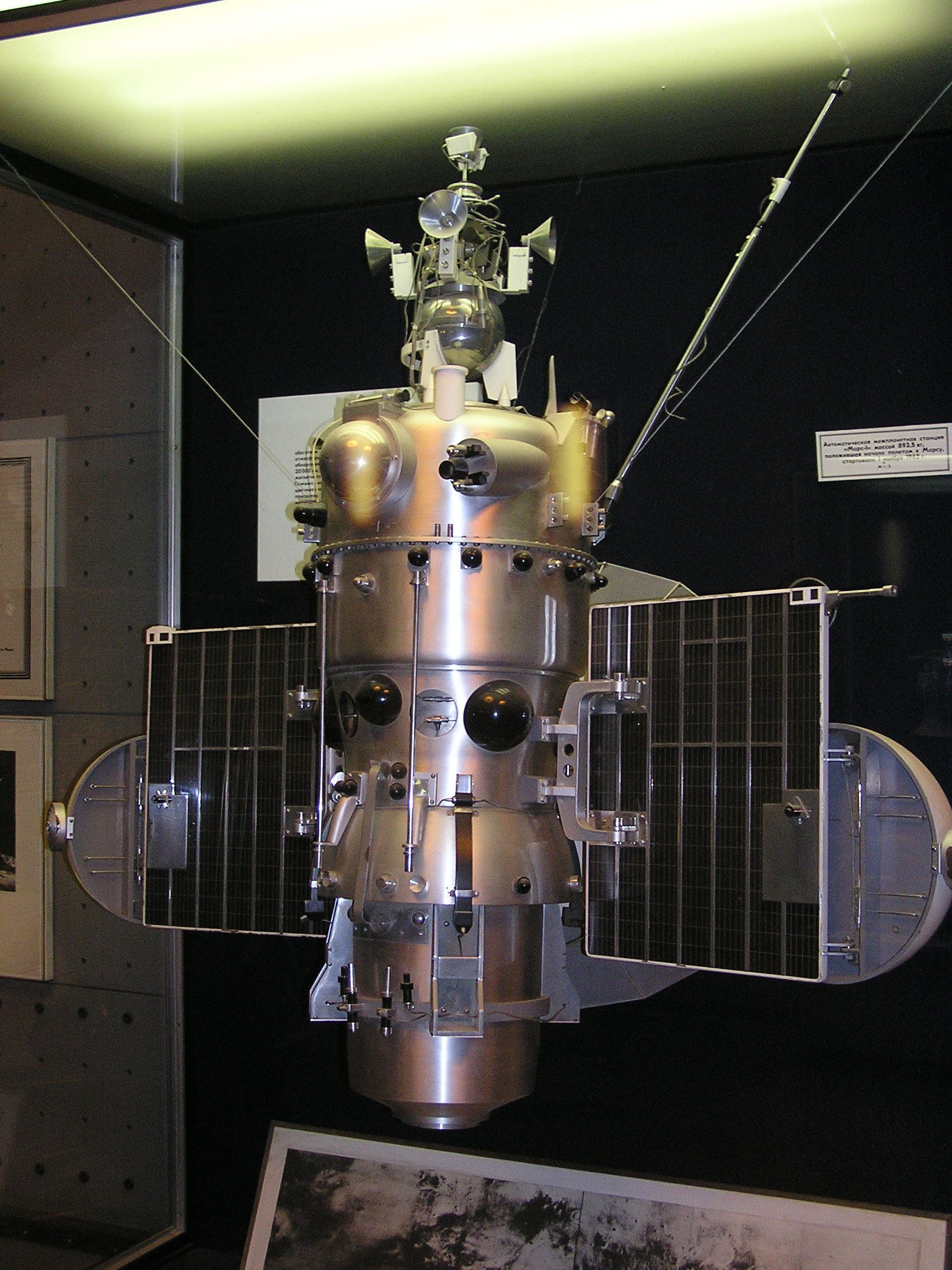
AMS "Mars-1" model.
Venus-1 is an automatic interplanetary station designed to study the planet Venus. Venus-1 was the first spacecraft to fly 100,000 km from the planet Venus. At various stages of launch, it was sometimes referred to as “heavy satellite 02” or “Sputnik-8”. Measurements of solar wind parameters (after the discovery of solar wind by Luna-1 station) and cosmic rays in the vicinity of the Earth, as well as at a distance of 1.9 million kilometers from the Earth, were transmitted from the Venera-1 station. As we know, Venus-1 traveled 41.4 million kilometers to Venus and the distance of 1.9 million kilometers in just 7 days before the connection was lost. The reason was a rather annoying circumstance. Communication with the satellite was not constant, but on command of the onboard automation, which was activated at a specified time and when it came out, communication became impossible. What happened. Subsequently, scientists have recognized that the costs with constant communication are not so critical and completely pay off, if the connection is not disconnected and the satellite is not lost forever. But even in such a short time that the station was in contact with the MCC, quite a lot of discoveries and innovations were made. It was the first device designed for the study of planets. For the first time, the orientation technique along the three axes of the spacecraft according to the Sun and the star Canopus was used. For the first time, a parabolic antenna was used to transmit telemetric information.
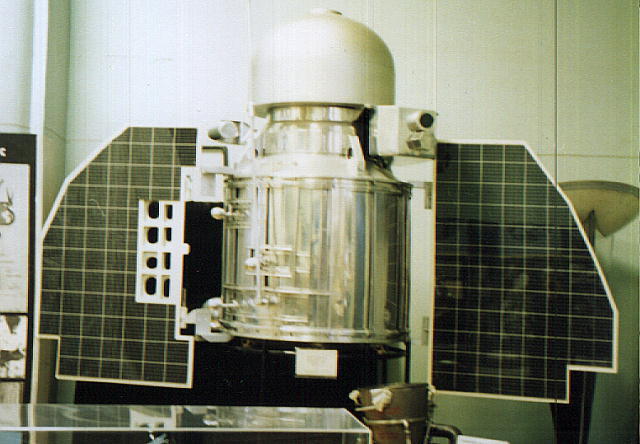
"Venus-1" is the first satellite sent to the nearest planet.
Soon, on November 12, 1965, the station Venera-2 and after 4 days the station Venera-3, which were planned to be planted on Venus, were launched. But because of problems in the control system, the task was never completed. The Venera-3 station was the first spacecraft to reach the surface of another planet, and the Venera-2 station flew over Venus at a distance of 24,000 km. During the flight with the station Venera-3, 63 communication sessions were conducted (26 with Venus-2). The stations stopped transmitting information already on the approach to the planet, and according to this, scientists have so far failed to obtain any data on the nearest neighbor.

"Venus-2"

"Venus-3" as seen from the photos, the stations were very similar.
The data obtained from the "Venus-3" were used to create the "Venus-4." The descent vehicle was supposed to operate at a temperature of 425 ° C and a pressure of up to 10 atmospheres. "Venus-4" consisted of an orbital compartment and a descent vehicle. The whole telemetric apparatus was in the orbital compartment, and in the descent capsule there was a parachute and sensors, pressure, gas and sensors for determining the density of the atmosphere.
At Venus-4, 6-bit telemetry was used with polling rates of 1, 4, 16, and 64 bit / s, which could work in the direct transmission mode, and in the recording mode with subsequent playback. For recording TM-information in standby mode, a tape recorder with a capacity of 150 thousand bits was part of the telemetry system. Information transfer with a speed of 64 bits per second was carried out through a parabolic highly directional antenna (IT) with a diameter of ~ 2.3 meters. The thermal control system provided gas circulation in the orbital compartment with the help of a fan, and the heat was discharged through a radiator-cooler built into the pointed antenna.
The radio transmitter of the descent vehicle used the same transmitter as on the orbital compartment. The transfer of telemetric and scientific information was carried out directly from the descent vehicle to the Earth. But, given the distance to Venus, as well as the fact that the transfer of scientific information was carried out through a low-directional antenna, the transmission rate of information was only 1 bit per second.
Before the launch, the descent vehicle was sterilized to prevent the introduction of microorganisms of terrestrial origin onto Venus.
After 128 days after launch, on October 18, 1967, the station Venera-4 became close to the planet. The descent vehicle at the entrance to the atmosphere of Venus, which occurred on the night side of the planet near the equator at 1500 km from the morning terminator, experienced overloads of 300 units.
The main result of the Venera-4 flight was the first direct measurements of the temperature, density, pressure and chemical composition of the atmosphere of Venus.
Gas analyzers showed a predominant content of carbon dioxide in the atmosphere of Venus (~ 90%) and a very low content of oxygen and water vapor.
Scientific instruments of the orbital apparatus of the station Venera-4 showed that Venus had no radiation belts, and the planet’s magnetic field was 3000 times weaker than the Earth’s magnetic field. In addition, using the indicator of UV radiation of the Sun, the hydrogen corona of Venus was found, containing about 1000 times less hydrogen than the upper atmosphere of the Earth. Atomic oxygen was not detected by the indicator.
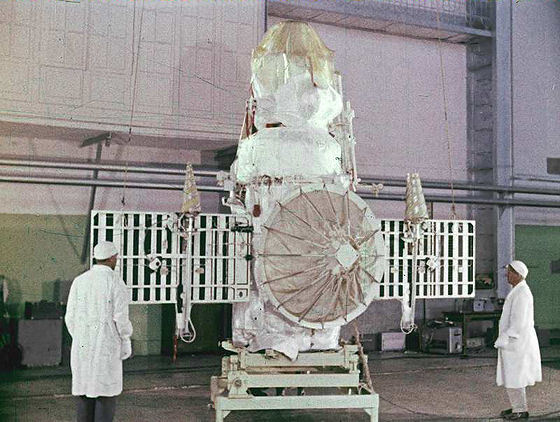
"Venus-4"

The descent vehicle "Venera-4"
The Venera-5.6 satellites also reached Venus, and received data to create a more advanced Venera-7 spacecraft.
The Venera-7 spacecraft was designed to deliver a descent vehicle to the surface of Venus.
Unlike previous expeditions, the main goal at launch in 1970 was already landing on the surface of the planet. Therefore, the wind speed at the surface of Venus, which by calculations was 1.5 m / s, was also included in the initial data.
Due to the increase in the mass of the descent vehicle by almost 100 kg compared with the descent vehicles Venus-5.6, the orbital compartment had to be lightened as much as possible. All scientific equipment was removed from it with the exception of the cosmic particle counter KS 18 4M.
But even after this, the mass of the entire apparatus (1180 kg) turned out to be 50 kg more than the mass of "Venus-5.6", which means it exceeded the capacity of the Molniya-M carrier. The carrying capacity of the carrier was increased by refining the tanks of the upper stage (it received the designation NVL), which made it possible to add 140 kg of fuel.
The main result of the flight of the station "Venera-7" was the achievement for the first time in the world of the surface of the planet Venus. At the same time, the device landed on the night side of Venus. Because of the failure of the telemetric switch, only pressure information was obtained, which is 90 ± 15 atmospheres, and the temperature is 475 ° ± 20 ° C.

"Venus-7"

The descent vehicle "Venus-7"
The spacecraft Venera-8 was an improved model of the Venus-7, by applying the data from the previous satellite. And on July 22, 1972, the station Venera-8 reached the planet. Upon entering the atmosphere of Venus, the descent capsule separated from the station. In the process of aerodynamic braking in the atmosphere, in which the device experienced overloads up to 335 g, its speed decreased from 11.6 km / s to 250 m / s, after which a parachute system was introduced at an altitude of ~ 55 km. With the opening of the parachute began the transfer of scientific and official information. After 55 minutes of smooth descent by parachute in the atmosphere, the vehicle landed on the illuminated side of Venus, 500 km from the morning terminator near the equator, with the vertical speed at the moment of touching was 8.3 m / s. Reception of the radio signal and telemetric information continued for another 50 minutes after landing. All this time, the onboard systems and scientific instruments worked normally, which made it possible to obtain complete information not only about the atmosphere of Venus, but also about the conditions on its surface.
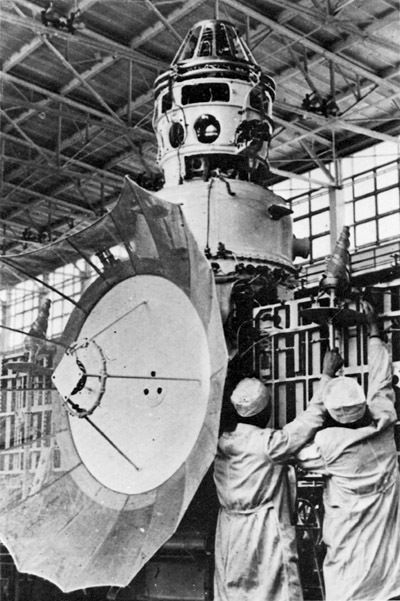
"Venus-8" is preparing to fly.
The following launches to Venus were already on the Proton, which I will discuss in the next part, since the Proton is a carrier rocket of a heavy class, its capabilities exceed all the missiles created in the USSR before it, which allows to put much more payload into space. The article promises to be very interesting.

Booster "Lightning"

Modified version of the Molniya-M launch vehicle
')
As is known, there are eight planets in the solar system. These are Mercury, Venus, Earth, Mars, Jupiter, Saturn, Uranus and Neptune. Pluto, previously considered the planet of the Solar System, is now excluded from this “honorable” series. The degree of remoteness from the Sun, the Earth is in third place. The planet nearest to the Sun is Mercury, and the most distant is Neptune.
The shortest distance from these planets to the Earth is as follows (in millions of km):
Mercury - 91.6
Venus - 41.4 the closest planet to Earth.
Mars - 78.3
Jupiter - 628.4
Saturn - 1277.4
Uranium - 2721.4
Neptune - 4347.4
We will need this information later, in order to understand the global nature of the steps taken by the USSR during the space race.
Booster "Lightning" 8K78. The first launch is October 10, 1960. And its modification "Molniya-M" 8K78M First launch April 2, 1964.
Developed for launching interplanetary spacecraft to Venus and Mars, then - for launching lunar spacecraft of the E-6 and E-6C series ("Luna-4" - "Luna-14") Gained fame in connection with the launches of communications satellite "Lightning" on orbits.
With the help of these devices, the problem of providing long-distance telephone and telegraph communication and retransmission of programs of the Central Television was solved.
It was later used for launching satellites of the Oko Alert Warning System (EWS).
It should be noted that this booster is one of the most successful. Now it is based on the Soyuz launch vehicles. Separately, it can be said about the Luna satellites that she launched into space. Of the 10 satellites, only 5 coped with their tasks. I would especially like to mention the station "Luna-9" and "Luna-13"
The Luna-9 station for the first time in the world made a soft landing on the surface of the Moon in the Ocean of Storms, west of the craters Reiner and Marius, at the coordinates of 64 degrees 22 minutes west longitude and 7 degrees 8 minutes north latitude. 7 communication sessions with a total duration of more than 8 hours were conducted with the station. During these sessions, the AMC transmitted a panoramic image of the surface of the Moon near the landing site.
The Luna-9 station worked for 7 days and transmitted three photo-panoramas of the lunar surface to Earth. In addition, the station was equipped with a penetrometer gage meter, radiation densitometer and dynamograph, with which the first ever instrumental study of the density and strength of the lunar soil surface layer was conducted

"Luna-9"

"Luna-9" with the landing module.

Picture of the descent module "Luna-9" on the background of its orbital module
The remaining stations “Luna - 10,11,12,14” did not land on our natural satellite, but did measurements of the near-moon space.

"Luna-10"
Mars and Venus satellites were also launched on these launch vehicles. The USSR once again threw primacy from the United States, but now it was the launch of a satellite to other planets.
Mars-1 is an automatic interplanetary station of the second generation of the Mars program. One of the three AMC series M-62. The spacecraft was designed to conduct scientific research of Mars from the flight trajectory, transmitting information about the interplanetary space and about the space around Mars. The first spacecraft for a flight to Mars, the Mars-1, was created at the SPO Design Bureau. Korolev and launched in 1962, but did not reach the planet.

AMS "Mars-1" model.
Venus-1 is an automatic interplanetary station designed to study the planet Venus. Venus-1 was the first spacecraft to fly 100,000 km from the planet Venus. At various stages of launch, it was sometimes referred to as “heavy satellite 02” or “Sputnik-8”. Measurements of solar wind parameters (after the discovery of solar wind by Luna-1 station) and cosmic rays in the vicinity of the Earth, as well as at a distance of 1.9 million kilometers from the Earth, were transmitted from the Venera-1 station. As we know, Venus-1 traveled 41.4 million kilometers to Venus and the distance of 1.9 million kilometers in just 7 days before the connection was lost. The reason was a rather annoying circumstance. Communication with the satellite was not constant, but on command of the onboard automation, which was activated at a specified time and when it came out, communication became impossible. What happened. Subsequently, scientists have recognized that the costs with constant communication are not so critical and completely pay off, if the connection is not disconnected and the satellite is not lost forever. But even in such a short time that the station was in contact with the MCC, quite a lot of discoveries and innovations were made. It was the first device designed for the study of planets. For the first time, the orientation technique along the three axes of the spacecraft according to the Sun and the star Canopus was used. For the first time, a parabolic antenna was used to transmit telemetric information.

"Venus-1" is the first satellite sent to the nearest planet.
Soon, on November 12, 1965, the station Venera-2 and after 4 days the station Venera-3, which were planned to be planted on Venus, were launched. But because of problems in the control system, the task was never completed. The Venera-3 station was the first spacecraft to reach the surface of another planet, and the Venera-2 station flew over Venus at a distance of 24,000 km. During the flight with the station Venera-3, 63 communication sessions were conducted (26 with Venus-2). The stations stopped transmitting information already on the approach to the planet, and according to this, scientists have so far failed to obtain any data on the nearest neighbor.

"Venus-2"

"Venus-3" as seen from the photos, the stations were very similar.
The data obtained from the "Venus-3" were used to create the "Venus-4." The descent vehicle was supposed to operate at a temperature of 425 ° C and a pressure of up to 10 atmospheres. "Venus-4" consisted of an orbital compartment and a descent vehicle. The whole telemetric apparatus was in the orbital compartment, and in the descent capsule there was a parachute and sensors, pressure, gas and sensors for determining the density of the atmosphere.
At Venus-4, 6-bit telemetry was used with polling rates of 1, 4, 16, and 64 bit / s, which could work in the direct transmission mode, and in the recording mode with subsequent playback. For recording TM-information in standby mode, a tape recorder with a capacity of 150 thousand bits was part of the telemetry system. Information transfer with a speed of 64 bits per second was carried out through a parabolic highly directional antenna (IT) with a diameter of ~ 2.3 meters. The thermal control system provided gas circulation in the orbital compartment with the help of a fan, and the heat was discharged through a radiator-cooler built into the pointed antenna.
The radio transmitter of the descent vehicle used the same transmitter as on the orbital compartment. The transfer of telemetric and scientific information was carried out directly from the descent vehicle to the Earth. But, given the distance to Venus, as well as the fact that the transfer of scientific information was carried out through a low-directional antenna, the transmission rate of information was only 1 bit per second.
Before the launch, the descent vehicle was sterilized to prevent the introduction of microorganisms of terrestrial origin onto Venus.
After 128 days after launch, on October 18, 1967, the station Venera-4 became close to the planet. The descent vehicle at the entrance to the atmosphere of Venus, which occurred on the night side of the planet near the equator at 1500 km from the morning terminator, experienced overloads of 300 units.
The main result of the Venera-4 flight was the first direct measurements of the temperature, density, pressure and chemical composition of the atmosphere of Venus.
Gas analyzers showed a predominant content of carbon dioxide in the atmosphere of Venus (~ 90%) and a very low content of oxygen and water vapor.
Scientific instruments of the orbital apparatus of the station Venera-4 showed that Venus had no radiation belts, and the planet’s magnetic field was 3000 times weaker than the Earth’s magnetic field. In addition, using the indicator of UV radiation of the Sun, the hydrogen corona of Venus was found, containing about 1000 times less hydrogen than the upper atmosphere of the Earth. Atomic oxygen was not detected by the indicator.

"Venus-4"

The descent vehicle "Venera-4"
The Venera-5.6 satellites also reached Venus, and received data to create a more advanced Venera-7 spacecraft.
The Venera-7 spacecraft was designed to deliver a descent vehicle to the surface of Venus.
Unlike previous expeditions, the main goal at launch in 1970 was already landing on the surface of the planet. Therefore, the wind speed at the surface of Venus, which by calculations was 1.5 m / s, was also included in the initial data.
Due to the increase in the mass of the descent vehicle by almost 100 kg compared with the descent vehicles Venus-5.6, the orbital compartment had to be lightened as much as possible. All scientific equipment was removed from it with the exception of the cosmic particle counter KS 18 4M.
But even after this, the mass of the entire apparatus (1180 kg) turned out to be 50 kg more than the mass of "Venus-5.6", which means it exceeded the capacity of the Molniya-M carrier. The carrying capacity of the carrier was increased by refining the tanks of the upper stage (it received the designation NVL), which made it possible to add 140 kg of fuel.
The main result of the flight of the station "Venera-7" was the achievement for the first time in the world of the surface of the planet Venus. At the same time, the device landed on the night side of Venus. Because of the failure of the telemetric switch, only pressure information was obtained, which is 90 ± 15 atmospheres, and the temperature is 475 ° ± 20 ° C.

"Venus-7"

The descent vehicle "Venus-7"
The spacecraft Venera-8 was an improved model of the Venus-7, by applying the data from the previous satellite. And on July 22, 1972, the station Venera-8 reached the planet. Upon entering the atmosphere of Venus, the descent capsule separated from the station. In the process of aerodynamic braking in the atmosphere, in which the device experienced overloads up to 335 g, its speed decreased from 11.6 km / s to 250 m / s, after which a parachute system was introduced at an altitude of ~ 55 km. With the opening of the parachute began the transfer of scientific and official information. After 55 minutes of smooth descent by parachute in the atmosphere, the vehicle landed on the illuminated side of Venus, 500 km from the morning terminator near the equator, with the vertical speed at the moment of touching was 8.3 m / s. Reception of the radio signal and telemetric information continued for another 50 minutes after landing. All this time, the onboard systems and scientific instruments worked normally, which made it possible to obtain complete information not only about the atmosphere of Venus, but also about the conditions on its surface.

"Venus-8" is preparing to fly.
The following launches to Venus were already on the Proton, which I will discuss in the next part, since the Proton is a carrier rocket of a heavy class, its capabilities exceed all the missiles created in the USSR before it, which allows to put much more payload into space. The article promises to be very interesting.
Source: https://habr.com/ru/post/226959/
All Articles